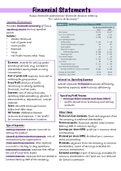Summary
Exam Summary Financial Management 2, FM2, AMSIB
- Course
- Institution
- Book
This is a summary for the Financial Management exam. It contains chapters 3-5, 10, and 15 of the book "Principles of Managerial Finance" by Lawrence J. Gitman and Chad J. Zutter. the summary has all equations and theory needed during the exam.
[Show more]




